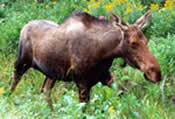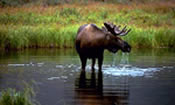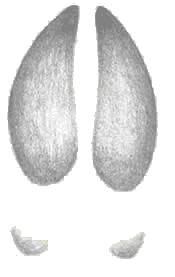Moose - (Alces alces)
Ontario, Canada
 Moose
Watching in Algonquin Park
Moose
Watching in Algonquin Park
The best moose watching is in Algonquin Provincial Park, along Highway 60 between May and June. During those months moose are attracted to the slightly salty water in the roadside ditches, as a result of winter sanding operations, since sodium has been lacking in their diet all winter moose stay around to take advantage of the sodium bonanza.
This also creates a serious hazard for motorists around this time of year. Every year moose are killed and many vehicles are damaged. So keep your eyes open and keep to the 80 Km per hour speed limit while driving through the park.
During June and July moose are able to get sodium from the new growth of aquatic plants and moose viewing continues to be excellent as moose are often spotted grazing out in the open in shallow bays or bever ponds. By end of July, moose for the most part spend their time browsing on leaves and twigs in the forest and are less visible along the roadside.
In late September and early October is the start of the rut season for Algonquin Park moose. Because bulls travel widely in search of receptive females this time of year moose tend to be seen more often, but not as often as in May and June.
Appearance
Males have palmate flat antlers with small prongs projecting. The front legs are longer than the back giving the moose a humped appearance. It has a short and stubby hairy tail, short neck, long nose, and ears like a mule. Under the throat hangs a pendant of fur about a foot long called a bell. In color the moose is dark brown to reddish brown with greyish white legs.
Habitat
Moose are found on the wooded hillsides of the rocky western mountain ranges, along the margins of ponds, lakes and rivers of the boreal forest, swamps, bogs and also on the northern tundra. They also can be found in fresh water feeding.
Range
Moose extend from the Alaska boundary all across Canada to the eastern tip of Newfoundland.
Food
 The
Algonkian Indians had an appropriate name for this magnificent animal.
Their word "mons" or "moz" (depending on the
dialect)—has been adopted into the English language as "moose."
Although the word we currently use offers scant information about
the animal, "twig eater"—a loose translation of the
Algonkian term—provides an apt description of its diet...
The
Algonkian Indians had an appropriate name for this magnificent animal.
Their word "mons" or "moz" (depending on the
dialect)—has been adopted into the English language as "moose."
Although the word we currently use offers scant information about
the animal, "twig eater"—a loose translation of the
Algonkian term—provides an apt description of its diet...
Although moose lack teeth in the front of the upper jaw, they have
little trouble dealing with the woody plant material that constitutes
much of their diet. They feed on fresh leaves by browsing and may
even pull a shoot sideways through their mouth, frequently stripping
off up to two feet (one-half metre) of vegetation with the aid of
the tough, thick tongue and lips. They also browse the tips of twigs,
particularly the most recent growth. Regardless of how it is attained,
the plant material is thoroughly crushed between twelve sets of
broad, flattened teeth at the rear of the mouth, six pairs of molars
and six pairs of premolars...Although many different plants are
eaten by moose, the type consumed depends on the availability, both
geographically and seasonally. In general, preferred trees and shrubs
include willows (Salix), trembling aspen (Populus tremuloides),
redosier dogwood (Comus stolonifera), red maple (Acer rubrum), striped
maple (Acer pennsylvanicum), white birch (Betula papyrifera), beaked
hazelnut (Corylus rostrata), pin cherry (Prunus pennsylvanica) and,
primarily in winter, balsam fir (Abies balsamea). Aquatic plants,
particularly water shield (Brasenia schreberi), yellow pond lily
(Nuphar sp.) and pondweed (Potamogeton sp.),constitute a preferred
and important part of the moose's diet in summer.
During the winter it feeds on twigs and shrubs - about (18 - 22 kg) (40 to 50 pounds) a day. In the summer moose eat many types of leaves of trees and shrubs such as birch and maple. They also feeds on water plants consuming a total of (22 - 27 kg) (50 to 60 lbs.) a day
Breeding Biology
 Most
of the year, moose are relatively silent animals. However, during
the breeding season, the rut, their silence is broken. Moose courtship
is elaborate, consisting not only of intricate vocalizations but
also of elegant visual displays and subtle chemical stimuli. Still,
much of the underlying mechanism of the rut has yet to be resolved,
for we are just beginning to unravel the complexities of this ageless
ritual.
Most
of the year, moose are relatively silent animals. However, during
the breeding season, the rut, their silence is broken. Moose courtship
is elaborate, consisting not only of intricate vocalizations but
also of elegant visual displays and subtle chemical stimuli. Still,
much of the underlying mechanism of the rut has yet to be resolved,
for we are just beginning to unravel the complexities of this ageless
ritual.
Moose often take more than one mate, but the bull usually stays with a given cow during most of the breeding season which begins in mid September.
The revitilizing warmth of the spring sun
incites a profound change in northern landscapes. Almost overnight,
vivid mosaics of spring flowers carpet the formerly barren forest
floor. Overhead, buds burst open, sending forth regiments of unfurling
leaves to capture the life-giving light. The air reverberates with
song as scores of vibrant birds return to proclaim territories and
attract desiring mates.
Spring is the season of birth for many animals, including the moose.
By early May, last year's offspring, a close companion of its mother
throughout the long, cold winter, is now considered an unwanted
intruder and is driven off by the cow as she seeks solitude in which
to bring forth the next generation.
The youngster must be tremendously confused when its dam, formerly
its source of life and nourishment, its consoler in times of stress
and its protector in the face of danger, suddenly rejects it. Bewildered
by this reversal in attitude, the calf attempts to reunite with
its Mother, only to be rebutted repeatedly. Ultimately, the rejection
is accepted, and the yearling must face the dangers of its world
alone. It may for a time drift around the periphery of the cow's
calving ground in the vain hope that she will discard her aggressiveness
and once again tolerate its presence. Or the yearling may wander
off, seeking a life completely on its own...
Predators/Threats
Black and grizzly bears are the main predators. Wolves kill them in winter when the snow is deep to their advantage or on ponds and lakes where it is easy for the moose to slip and fall. Wolverines and cougars are also known to kill calves. On the Island of Newfoundland, moose is an important game animal, with approximately 22,000 being harvested yearly.
Lifespan
Moose can live 20 years or more in the wild.
A moose in its prime has little to fear
from most predators, for few animals apart from man possess the
ability to kill it. Timber wolves (Canis lupus) tend to take either
calves separated from their mothers or sick or disabled animals.
There are recorded accounts of adult moose standing their ground
and successfully fending off entire packs of wolves. The front feet
of a moose, as well as its hind ones, are lethal weapons that will
take their toll on unwary adversaries. Wolves, opportunists by nature,
often scavenge on moose that have died from other causes. In so
doing, they often are erroneously blamed for causing the demise
of those moose.
Black bears (Ursus arnericanus), being rather small bears, tend
to prey primarily on newborns or exceptionally young moose. In western
North America, Grizzly bears (Ursus arctos), larger and more powerful
than their dark relatives, have been known on occasion to take adult
moose, particularly in late winter when they leave their dens and
the crusty snow hinders a moose's movements. As a rule, however,
these large predators seem to have little negative effect on moose
populations and in some ways may be deemed beneficial by removing
animals in poor or diseased condition.
Perhaps the most serious, rather sinister threat to moose comes
not from large predators, such as bears and wolves, but from a rather
surprising source - the white-tailed deer (Odocoileus virginianus).
Where the ranges of moose and white-tailed deer overlap in North
America, moose frequently develop a fatal illness commonly known
as moose disease...
While many of the afflictions affecting moose do not cause permanent disability, as noted, some can prove fatal. Unfortunately, many people consider the death of a large animal to be tragic and believe the loss of life a waste. In the natural world, however, there is no waste. When a moose dies, every body component, whether flesh, hair or bone, is used by other living organisms. The list of animals that scavenge a moose carcass is almost endless and includes eagles, ravens, foxes, martens, fishers, wolverines and bears. The death of one moose may mean life for countless other organisms, particularly during the critical season of winter. When predators, disease, parasites or environmental stress strike, the less fit (the weakest) are usually the first to succumb. This "weeding out" of the less fit through the actions of a powerful force known as natural selection tends to result in a healthier, more fit population, which through future generations may exhibit greater resistance to those same environmental stresses.
Prints:
Moose move gracefully, leaving a neat, alternating track. The hind prints directly or double register on the fore prints. In winter they feed in willow flats and coniferous forests, leaving a distinct browseline. Ripped stems and gnawed bark, 6 feet (1.8 m) or more above ground are signs moose have been around.
|
Fore and Hind Prints
Length:4.0 - 7.0 in (10-18 cm) to 11 in
(28 cm)
Width: 3.5 - 5.8 in (8.9 - 15 cm)
Straddle
8.5 - 20 in (22-51 cm)
Stride
Walking: 1.5 - 3.0 ft (46 - 91 cm)
Trot: to 4.0 ft (1.2 m)
Size (bull>cow)
Height: 5.0 - 6.5 ft (1.5 - 2.0 m) .
Length: 7.0 - 8.5 ft (2.3 - 2.6 m)
Weight
Males 850 to 1180 lbs. (385 - 534 kg)
Females 600 to 800 lbs. (270 - 362 kg).
Similar Species:
White-tailed Deer and Elk
Notes:
An important big game animal for meat and
trophies.
Moose can swim as fast as two men paddling a canoe and run up to
56 kmph on land.
In North America the moose is the largest member of the deer family


